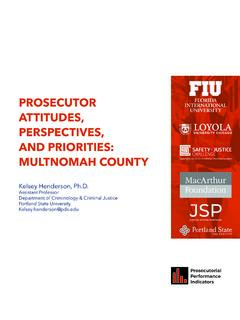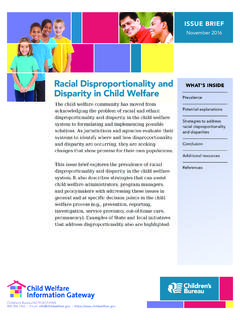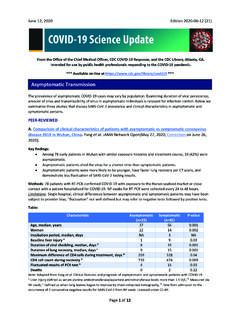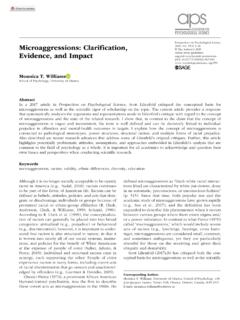Transcription of Grant Making with a Racial Equity Lens - GrantCraft
1 Grant Making WITH A Racial Equity LENS w w w. g r a n t c r a f t . o r g24 91322 Grant Making Racial Equity LENSWIT hAgrantcraft PRACTICAL WISDOM FOR GRANTMAKERSWhat is a Racial Equity lens?How a Racial Equity lens worksApplying a Racial Equity lensImplementing a commitment to Racial equityLooking inward: using a Racial Equity lens inside your foundationIn partnership withPAGE What Is a Racial Equity Lens?For Grant makers and founda-tion leaders, using a Racial Equity lens means paying disciplined attention to race and ethnicity while analyzing problems, looking for solutions, and defining success.
2 Some use the approach to enhance their own perspectives on Grant Making ; others adopt it as part of a commitment endorsed across their 4 How a Racial Equity Lens WorksA Racial Equity lens is valu-able because it sharpens Grant makers insights and improves the outcomes of their work. People who use the approach say it helps them to see pat-terns, separate symptoms from causes, and identify new solutions for their communities or 9 Applying a Racial Equity Lens: Skills and StrategiesWhere, specifically, does a Racial Equity lens get put to use by individual Grant makers? The answer is simple: every-where. A keen awareness of race and ethnicity , and of their impact on access to power and opportunity, is a distinct asset when applying the classic skills of effective Grant 13 Implementing a Commitment to Racial Equity : Policies and Practices When a foundation decides to focus on Racial Equity , how does that commitment get translated into the organi-zation s goals and routines?
3 Foundation leaders and pro-gram staff share examples of what they have learned about applying a Racial Equity lens to their programming, operations, and external Looking Inward: Using a Racial Equity Lens Inside Your FoundationGrant makers who have cham-pioned Racial Equity within their foundations describe a handful of tactics for getting over the predictable hurdles. Ground the discussion of Racial Equity in the foundation s mission, they say, be open to learning, and be upfront about your goals. But don t lose sight of the possibility of resistance and setbacks. Grant Making with a Racial Equity lensSPECIAL FEAtURES8 Your Race/Your Role: Reflections from Grant Makers19 Racial Equity Resources 20 Three Foundation Tools for Activating a Racial Equity Lens27 Questions to Ask Inside Your Foundation28 Ways to Use This Guide IN tHIS GUIDE, Grant makers explain why a focus on Racial Equity gives them a powerful lens for understanding and advancing their work.
4 Drawing on firsthand experiences, the guide offers advice on promoting and deepening your foundation s commitment to Racial Equity , both internally and in the programs you guide was developed by GrantCraft in partnership with the Philanthropic Initiative for Racial Equity (PRE). It was written by Julie Quiroz-Martinez in collaboration with Lori Villarosa for PRE and Anne Mackinnon for GrantCraft . It is part of the GrantCraft for this guide was provided by the Ford Foundation and the Charles Stewart Mott Foundation. Publications and videos in this series are not meant to give instructions or prescribe solutions; rather, they are intended to spark ideas, stimulate discussion, and suggest possibilities.
5 Comments about this guide or other GrantCraft materials may be sent to Jan Jaffe, project leader, at order copies or download .pdf versions of our publications, please visit are welcome to excerpt, copy, or quote from GrantCraft materials, with attribution to GrantCraft and inclusion of the copyright. 2007 GrantCraftGRANT Making WITH A Racial Equity LENS 1 What Is a Racial Equity Lens?For Grant makers, a Racial Equity lens brings into focus the ways in which race and ethnicity shape experiences with power, access to oppor-tunity, treatment, and outcomes, both today and historically. It can also help Grant makers think about what can be done to eliminate the resulting inequities.
6 Today, an increasing number of foundations are discussing and addressing Racial inequity, both internally and within their fields or communities. Grant Making WITH A Racial Equity LENSMany Grant makers say that a commit-ment to Equity for people of all Racial or ethnic groups is essential to effective philanthropy, yet embracing that com-mitment explicitly can be difficult for a foundation. Why is that true? First, as one Grant maker of color explained, the problem of Racial inequity can seem so complex and intractable that it s hard to imagine how a foundation could address it. Second and more simply, race is a difficult topic to discuss; people avoid it in foundations just as they do in other sectors of society.
7 A white foundation executive put it this way: My concern, he said, is that foundations are not pushed, nor do we push ourselves, hard enough on the issue of Racial Equity . We stand above the fray when we should be deeply involved in it. So, what s a good way to get thinking and discussion started? How do Grant makers make the case for Racial Equity as a priority in a foundation s Grant Making agenda? One approach is to begin by describ-ing a racially equitable society. Here s a useful definition: a racially equitable society would be one in which the distribution of resources, opportuni-ties, and burdens was not determined or predictable by race.
8 A white Grant maker at a Midwestern community foundation translated that vision into practical terms for his region: When we look in the long term, 20, 30 years WHAT DO WE MEAN BY RACE?This guide treats race as a social construct, not a biological one. We understand the term race to mean a Racial or ethnic group that is generally recognized in society and, often, by government. When referring to those groups, we primarily use the terminology people of color (or the name of the specific Racial and/or ethnic group) and white. We also understand that Racial and ethnic categories differ internationally. In some societies, ethnic, religious, or caste groups are oppressed and racialized.
9 These dynamics can occur even when the oppressed group is numerically in the majority. down the line, we hope to see no statistical differences in key indica-tors such as education, or health , or economic opportunity based on race. His explanation makes clear that a Racial Equity lens is not about particular groups; rather, it is about how race shapes the allocation of power and the distribution of benefits and burdens among all groups within society. It also illustrates why diversity and inclusiveness are important com-mitments but ultimately not power-ful enough to drive the changes his foundation hopes to advance.
10 Racial Equity stands in contrast to the notion that the best approach to issues of race is colorblindness. A Latino Grant maker who set out to reorient his foundation s education programming to address Racial inequi-ties ran up against that perspective repeatedly. He recalled: We were told left and right, You re looking at it the wrong way. Why don t you take a rising-tide-raises-all-boats sort of approach? The problem is, we have such deep segregation in our public and parochial school systems that the boat the black and brown kids are in isn t good to begin with. As he sees it, despite undeniable progress over the last few decades in dismantling state-sanctioned Racial discrimination in the United States, affirmative efforts are necessary to counter long-term pat-terns.






